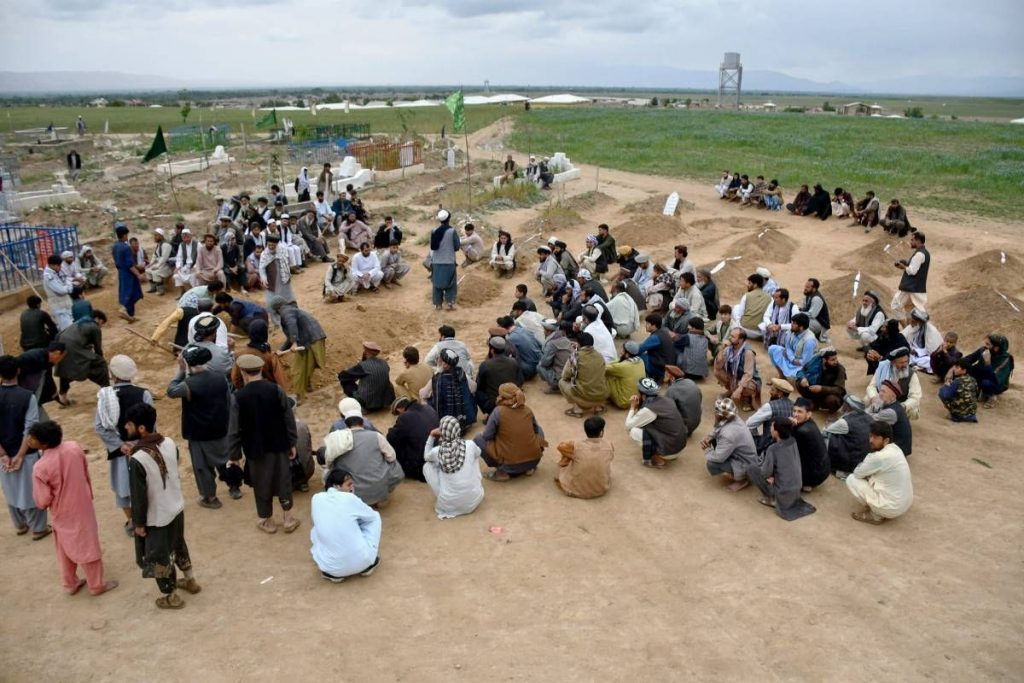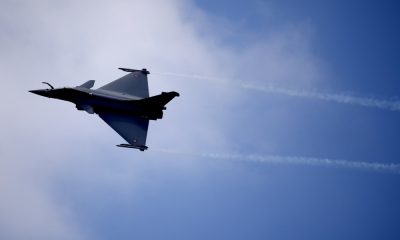MIDDLE EAST
Floods in Afghanistan leave over 300 dead and survivors with no home

At least 315 people have lost their lives, thousands of homes were damaged and livestock wiped out during the recent flash floods caused by heavy rain in northern Afghanistan.
Taliban authorities announced that over 1,600 people were wounded and the villagers buried their dead and aid agencies scrambling to help the survivors. “The death toll has exceeded 300, and sadly, we expect this number to rise. The flood has also destroyed more than 2,000 homes,” the UN’s International Organization for Migration (IOM) said on X.
Most of the casualties were reported in the northern Baghlan province where the floods destroyed 3,000 homes, damaged farmland, and washed away livestock. People are in desperate need as the deadly flood also damaged health centers.
Taliban’s Deputy Prime Minister for Economic Affairs, Abdul Ghani Baradar had visited Baghlan and met with the victims. He called on the aid organizations and the traders to help the affected people and the residents are in a deep shock as they buried dozens of bodies. The most of the victims are from Nahrin district
We have not food and no drinking water
“We have no food, no drinking water and no shelter or blankets,” said Najibullah, who has lost nine members of his family. Three children are among the casualties.
The United Nations Office for the Coordination of Humanitarian Affairs (OCHA) said that heavy rainfall and flash floods affected 21 districts across Badakhshan, Baghlan, and Takhar provinces.
At least 73 people have lost their lives and 76 others were wounded in Baghlani Jadid district where 1,500 houses have been damaged or destroyed. “In Burka district, 70 deaths and 150 injuries have been confirmed, along with damage to 5,000 homes. Elsewhere, 13 deaths were reported across Dahnai Ghori, Guzargah Noor, Jelga, Narin and Puli Khumri districts where 1,612 homes were reportedly destroyed or damaged. A further 603 homes were reported as such in Khost and Tala wa Barfak districts,” it said in a statement.

Afghan relatives offer prayers during a burial ceremony, near the graves of victims who lost their lives following flash floods after heavy rainfall at a village in Baghlan-e-Markazi district of Baghlan province.
At least 24 people were reportedly killed across Chall, Ishkamish, Farkhar and Namak Ab districts in Takhar province, with 14 injured and a further seven missing. More than one hundred homes were also reportedly destroyed or damaged – the vast majority in Chall and Ishkamish districts.
Baghlan, Badakhshan and Takhar provinces are affected the most
In Badakhshan province, Teshkan district has been the most affected with 200 homes, 50 bridges and 30 electricity dams destroyed or damaged and 2,000 animals killed.
“With every beat of our hearts, we feel the deep sorrow that’s befallen Baghlan and all of Afghanistan. In this tragic time, our spirits reach out to embrace the families in mourning,” the International Labour Organization (ILIO) covering Afghanistan said in X.
UN Special Rapporteur Richard Bennett, said that “recent floods in Afghanistan including Baghlan which claimed many lives, are a stark reminder of Afghanistan’s vulnerability to the climate crisis and both immediate aid and long term planning by the Taliban and international actors are needed”.
Recent floods are stark reminder of Afghanistan’s vulnerability to the climate crisis
Indrika Ratwatte, deputy special representative of UNAMA for Afghanistan said that the country has remained amongst the world’s top 10 climate impacted countries while having no significant carbon footprint. “Climate shocks continue to ravage vulnerable communities. Urgent support for climate adaptation and mitigation for the people of Afghanistan is a critical need,” he added.
He furthered that Afghanistan Humanitarian Fund (AHF) will remain the main funding platform for providing life saving humanitarian assistance to millions. The international community needs to step up and support this critical lifeline for the people of Afghanistan, he added.
At the same time the World Health Organization’s Director-General, Tedros Adhanom Ghebreyesus said that WHO and its partners have deployed 17 mobile health teams to assist flood victims in Afghanistan.
In a post on X, Tedros emphasized that the recent floods resulted in more than 300 deaths and caused extensive damage to homes and health facilities.
“We are providing essential medicines and medical supplies to the affected communities,” he added.
MIDDLE EAST
Israel’s reserve crisis deepens amid Gaza plans

As the Israeli army prepares to intensify its attacks in Gaza, the crisis within its reserve forces, considered the “backbone of the army,” is growing.
According to a report in Haaretz, tens of thousands of reserve soldiers are expected to be recalled to duty as Israel prepares to escalate its operations in Gaza. However, army officials report that motivation is declining, and an increasing number of reservists are stating they will not report for duty. Officials indicate that the reasons for this drop in motivation include war fatigue, the lack of clear objectives for the ongoing conflict, and anger towards government policies.
A senior reserve commander informed Haaretz that brigade and battalion commanders are handling numerous cases involving reserve soldiers refusing to report for duty. The most frequently cited reason is the perception that the government is making insufficient efforts to rescue the hostages. This is followed by anger over the proposed law exempting ultra-Orthodox Jews from military service and discontent regarding judicial reform plans.
Another reserve officer reported that soldiers and commanders suffer from severe burnout after serving hundreds of days over the past year. He expressed that they struggle to commit to new missions not only for political reasons but also due to physical and psychological fatigue.
Among those refusing service is combat pilot Alon Gur, who publicly announced his resignation last week after 16 years of service. Declaring his departure from the Air Force, Gur stated on social media, “The line has been crossed,” accusing the government of “prioritizing politics over human life.” After Gur was relieved of duty, other reserve soldiers began taking similar actions, causing significant concern within the army command.
According to Israeli army data, as of February, the reserve participation rate stood at 85%. At the start of the war, however, almost all called-up reservists reported for duty, marking the highest reserve mobilization in Israeli history.
Israel, with its relatively small population, relies on its reserve forces system to sustain the army during prolonged conflicts. This system, which involves recalling individuals who have returned to civilian life after compulsory military service back to active duty when needed, is considered one of the cornerstones of Israel’s security doctrine. This system allows tens of thousands of experienced soldiers to be rapidly deployed to the front lines during times of war or crisis.
MIDDLE EAST
Hamas retains guerrilla capacity and political role in Gaza, says US intelligence

According to the 2025 Threat Assessment Report from the US Intelligence Community, the umbrella organization for 18 separate intelligence agencies, Hamas retains the capacity to sustain low-intensity guerrilla warfare and remains a primary political actor in Gaza. In Lebanon, Hezbollah, noted as weakened post-war, is still described as posing a threat to Israel and the US.
According to a report in Haaretz, the assessment predicted that “tension will persist regarding the situation in Gaza, as well as in the Israel-Hezbollah and Israel-Iran dynamics” and stated that Hamas “will continue to pose a threat to Israel’s security even in its weakened state.”
The report also noted that Hamas’s October 7 attack on Israel disrupted the diplomatic progress achieved through the Abraham Accords and the trend toward stability in the Middle East.
Pointing out that Hamas has preserved thousands of its fighters and a significant portion of its underground infrastructure, the report warned that the organization “likely used the ceasefire to bolster its military capacity and replenish ammunition stocks.”
The report stated, “Hamas retains the capacity to reignite low-intensity guerrilla resistance and will remain the dominant political actor in Gaza for the foreseeable future. The low expectations among the parties for a permanent ceasefire and the absence of a post-war political and reconstruction plan point towards instability that could last for years.”
Noting that support for Hamas among Palestinians in the West Bank is higher compared to the Palestinian Authority, the report assessed that “the long-term trajectory of Israeli-Palestinian relations will depend on developments in the increasingly unstable West Bank.”
The report also highlighted that the Palestinian Authority’s capacity to provide security and public services in the West Bank is progressively weakening, emphasizing that Israeli operations in the West Bank, attacks by Jewish settlers, and the activities of Palestinian armed groups, including Hamas, could further deepen the governance crisis.
It added, “A potential leadership change within the Palestinian Authority could exacerbate governance challenges. Furthermore, how Israel will govern post-war Gaza and whether its operations in the West Bank will undermine the Palestinian Authority will also be crucial factors.”
The report also drew attention to the fragile dynamics between Israel and Lebanon, warning that a resumption of large-scale Israeli operations in Lebanon could heighten sectarian tensions, weaken Lebanese security forces, and worsen the humanitarian crisis.
The report concluded, “Despite being weakened, Hezbollah retains the capacity to target Americans and US interests regionally and globally, and even, to a limited extent, on US soil.”
MIDDLE EAST
US presents conditions to HTS for potential sanctions relief

According to six sources speaking to Reuters, the US has presented Hayat Tahrir al-Sham (HTS), which seized power in Syria, with a list of conditions to fulfill in exchange for partial sanctions relief. These conditions reportedly include ensuring foreigners do not hold senior management roles.
Two individuals, an American official and a Syrian source knowledgeable about the matter, told the news agency that US Deputy Assistant Secretary of State for Levant and Syria Natasha Franceschi conveyed the list of demands during a face-to-face meeting with Syrian Foreign Minister Asaad al-Shaybani. The meeting took place at the Syria donors conference in Brussels on March 18.
The sources indicated that the conditions put forward by the US include Syria “destroying its remaining chemical weapons stockpiles” and “cooperating in the fight against terrorism.”
Additionally, American officials and one source in Washington stated that another demand involves ensuring foreign militants are not appointed to senior government positions within Syria’s administrative structure. Criticism had previously arisen over Syria’s appointment of thousands of foreign militants—including Uyghurs, Jordanians, Chechens, and individuals of other nationalities—to the defense ministry.
According to two sources, Washington also requested that Syria appoint a liaison officer to assist in efforts to locate US journalist Austin Tice, who disappeared in Syria more than a decade ago.
The source also indicated that the US wants Syria to issue a statement supporting its own territorial integrity.
Washington reportedly did not provide a specific timeline for the fulfillment of these conditions.
While the HTS administration has not commented on the matter, the US State Department stated, “We do not discuss our private diplomatic conversations publicly.”
Department spokesperson Tammy Bruce mentioned last week that Washington is monitoring the actions of the interim administrators.
-

 EUROPE5 days ago
EUROPE5 days agoF-35 debate intensifies across Germany and Europe
-

 EUROPE1 week ago
EUROPE1 week agoEurope plans for US absence in NATO with 5-10 year strategy
-

 ASIA2 weeks ago
ASIA2 weeks agoChina’s AsiaInfo expands with DeepSeek-powered AI
-

 EUROPE2 weeks ago
EUROPE2 weeks agoFrench defense industry gears up for war amid EU strategic autonomy push
-

 AMERICA2 weeks ago
AMERICA2 weeks agoTrump’s tariffs drive Nvidia to invest heavily in US manufacturing
-

 DIPLOMACY6 days ago
DIPLOMACY6 days agoTrump’s proposed fees on Chinese ships threaten US maritime industry
-

 DIPLOMACY2 weeks ago
DIPLOMACY2 weeks agoUS, Britain, and Türkiye excluded from EU armament fund
-

 ASIA1 week ago
ASIA1 week agoIndia shelves $23 billion plan to rival China’s factories


















